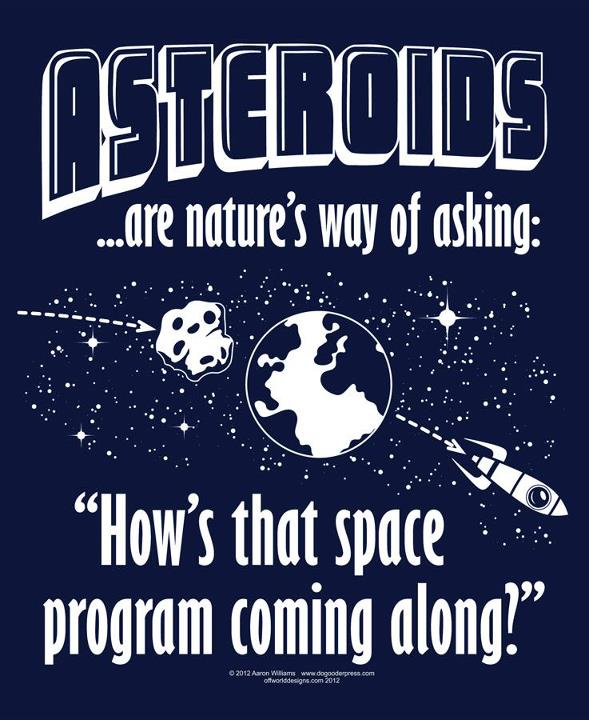February 16, 2013
Asteroid Addendum
Well, that was exciting.
We had a near miss from an asteroid big enough to cause a 5 megaton blast if it hit. Over a thousand people were injured in Russia this morning when a small meteor detonated above (and impacted just outside of) the town of Chelyabinsk. This afternoon, bolide exploded above Rodas Cuba causing minor damage and another bolide lit up San Fransisco this evening but did no damage.
The near miss asteroid has pretty much been established to be unrelated to the Russian meteorite, though its unclear if the two bolides were related to the Russian event.
2012DA14 which passed inside Geostationary Orbit got some buzz in the press over the last few days and Drudge, of course, hyped it like it was the Sweet Meteor Of Death. It was discovered by an amateur astronomer in Spain, not NASA or any other credentialed body, so if not for him we never would have seen it coming until it was upon us (if then). If it had been the tiniest bit off its actual course it would have hit. At this point we could have done nothing about it.
The objects that caused so much excitement in Chelyabinsk, Rodas and San Fransisco, well, we never saw them coming.
This pic is making the rounds today....because it's true.

Comments are disabled.
Post is locked.
We had a near miss from an asteroid big enough to cause a 5 megaton blast if it hit. Over a thousand people were injured in Russia this morning when a small meteor detonated above (and impacted just outside of) the town of Chelyabinsk. This afternoon, bolide exploded above Rodas Cuba causing minor damage and another bolide lit up San Fransisco this evening but did no damage.
The near miss asteroid has pretty much been established to be unrelated to the Russian meteorite, though its unclear if the two bolides were related to the Russian event.
2012DA14 which passed inside Geostationary Orbit got some buzz in the press over the last few days and Drudge, of course, hyped it like it was the Sweet Meteor Of Death. It was discovered by an amateur astronomer in Spain, not NASA or any other credentialed body, so if not for him we never would have seen it coming until it was upon us (if then). If it had been the tiniest bit off its actual course it would have hit. At this point we could have done nothing about it.
The objects that caused so much excitement in Chelyabinsk, Rodas and San Fransisco, well, we never saw them coming.
This pic is making the rounds today....because it's true.

Next time the S.M.O.D. Squad comes visiting they may not be so congenial.
Posted by: The Brickmuppet at
05:55 AM
| Comments (1)
| Add Comment
Post contains 234 words, total size 2 kb.
1
I'm reminded of a theory I read about several years ago related to how our solar systems moves through the galaxy. The position of stars relative the dense galactic spiral arms is not fixed. The stars orbit the galaxy at a different rate than the dense regions which form the arms, passing through them periodically similar to how cars pass through slower regions of traffic during rush hour on a freeway. All the stars clump up as they pass through the density wave of the arm, then spread out again as they orbit past it.
According to the theory, when our solar system passes through one of these denser regions, the reduced distance to nearby starts disturbs the Oort cloud and long period comets, causing more of them to pass Earth's orbit than when we are in the "quiet zone" between galactic arms. Some of those long period comets could be very old, and have lost the majority of their ice in previous encounters near the sun, and thus appear as rocky asteroids, such as the one which just hit Russia.
The article I read suggested that the time it takes our solar system to orbit out of one spiral arm to the next matches the interval between mass extinctions on Earth. Also, we're supposedly beginning our approach to the next spiral arm now...
According to the theory, when our solar system passes through one of these denser regions, the reduced distance to nearby starts disturbs the Oort cloud and long period comets, causing more of them to pass Earth's orbit than when we are in the "quiet zone" between galactic arms. Some of those long period comets could be very old, and have lost the majority of their ice in previous encounters near the sun, and thus appear as rocky asteroids, such as the one which just hit Russia.
The article I read suggested that the time it takes our solar system to orbit out of one spiral arm to the next matches the interval between mass extinctions on Earth. Also, we're supposedly beginning our approach to the next spiral arm now...
Posted by: Siergen at Sat Feb 16 17:05:07 2013 (Ao4Kw)
27kb generated in CPU 0.0144, elapsed 0.1139 seconds.
69 queries taking 0.104 seconds, 272 records returned.
Powered by Minx 1.1.6c-pink.
69 queries taking 0.104 seconds, 272 records returned.
Powered by Minx 1.1.6c-pink.









